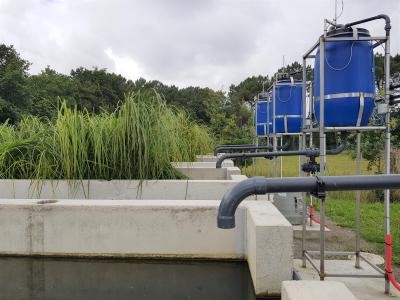An oasis of waste reconverted into ceramic materials
Transforming industrial waste and unused by-products could make it possible to respond to issues of scarcity for civil engineering resources, recyclability and even reducing use of fossil fuels. Doan Pham Minh, process engineering researcher at IMT Mines Albi, explains several avenues for recycling and reusing materials explored by his work.
One man’s trash can be another man’s treasure. Turning rubbish into resources is the aim of the circular economy. And it is also the issue at the heart of the Innovative Ceramic Materials for Energy Storage and Construction (MACISEB)[1] project, launched in 2019, with the participation of researchers from IMT Mines Albi[2]. “Our objective is to transform inorganic, industrial waste and by-products, which can be found around us, into something that is useful for society,” describes Doan Pham Minh, process engineering researcher. The solutions identified as part of the project will then be transferred to companies in the Occitania region. From finding other uses for unrecyclable waste to replacing raw materials that are running out, the principle of ‘second life’ can be applied to a large range of unexpected situations.
Sand reserve seeks replacement for time to rest and recuperate
The French Agency for Ecological Transition (Ademe) reports that between 27 and 40 billion tons of sand are extracted each year around the world. It can be found in our buildings and windows, as well as our computers. “The demand for this resource is even more critical than that for noble metals. And the reserves are running out so quickly that they are arriving at breaking point,” emphasizes Pham Minh. Extracted from quarries or taken from riverbeds, natural sand is formed by the lengthy process of erosion. Too long, therefore, to meet society’s needs. However, this material is indispensable for the civil engineering sector (its main consumer) and therefore the economic stability of many countries.
Read more on I’MTech: Sand, an increasingly scarce resource that needs to be replaced
This is why the MACISEB project is seeking sand replacement products from inorganic by-products, i.e. industrial waste that is not currently being used. “The idea is not to completely change our means of manufacturing, but to replace a critical raw material using a circular economy approach,” specifies Pham Minh. With his team, the researcher has created resource maps for the entire Occitan territory. He identified and located deposits with high potential and similar properties to sand. He also ensured that these products are sustainable, by noting the quantity and availability of this waste. In this way, multiple candidates were selected, including glass residue.
During the recycling process, glass is ground up into grains fine enough to be reused by glass factories. However, a portion of this glass, too fine, coarse or contaminated, is not reused. “We are recovering this leftover glass to replace part or all of the sand needed to make ceramic bricks or tiles,” specifies Pham Minh. Sand from foundries, slag from blast furnaces, and ashes from biomass thermal power plants are also promising.
Using these materials, researchers have suggested formulas to create bricks and tiles with the same mechanical and thermal properties as those made with clay and natural sand. Moreover, the formulas comply with industrial specifications. The products are therefore guaranteed to be able to be manufactured using equipment that companies already possess, without extra investment. The first bricks will be made in 2022, and then tested by the Scientific and Technical Center for Building (CSTB).
From wind to heat: reusing wind turbine blades
The operating lifespan of a wind turbine is estimated at around twenty years. This means that the first French facilities are now arriving at end-of-life, and there will have to be more dismantling in the coming years. In short, recycling is becoming a major challenge for the wind energy industry. While the parts made from metal (pole and rotor) and concrete (base) recycle well, the blades – made from glass fiber mixed with organic resin – are not so lucky. Another part of the MACISEB project involves researchers recycling this waste into thermal storage materials. “Our objective is to reuse glass fiber from the blades to develop ceramics used by concentrated solar power (CSP) plants,” explains the researcher. This means of energy production transforms solar energy first into heat, then electricity. To do so, it uses systems made up of mirrors that concentrate the sun’s rays at one point, generating extremely high temperatures (from 200 to 1,500°C). The heat is transported by fluid, to propel the turbines and produce. It can be stored in ‘thermal batteries’, to later be released during the night to ensure continuity of service.
At present, thermal power plants store heat using molten salt – a mixture of potassium nitrate and sodium nitrate. “These compounds can also be found in agricultural fertilizer. There is therefore a conflict of use between the two sectors. However, there is currently no commercial alternative that is economically and environmentally viable,” explains Pham Minh. Transforming turbine blades into ceramics would therefore provide a new solution for this sector. With this in mind, researchers are developing materials capable of handling intense, repeated cycles of heating and cooling for multiple years. This solution would eventually make it possible to reuse a waste product that promises to grow. But it will also give a technological boost to the thermodynamic solar energy sector, which could allow it to establish itself in the renewable energy market. As part of the MACISEB project, this research is being undertaken by the PROMES laboratory, a partner of the project and academic reference body in the area of thermal storage. ART-DEV, partner and social sciences laboratory, is also looking into the social conditions for recycling wind turbine blades and the possibility of implementing a recycling ecosystem for the blades at a regional scale.
Industrial fumes: an idea to get the turbines going
Another application could make use of ceramic materials made from inorganic waste to capture heat. At present, the industry squanders over 30% of the energy it consumes in the form of so-called waste heat, released into the atmosphere in industrial fumes. Researchers at IMT Mines Albi are collaborating with company Eco-Tech Ceram, specialist in thermal storage, in order to recover this energy, store it and use it to supply industrial processes. For example, ceramicists and metal-working factories use high-temperature ovens, often running on natural gas. Reusing the heat captured from their fumes would make it possible to partially heat their equipment and therefore reduce their fossil fuel consumption.
Like for thermodynamic solar, the challenge is therefore to develop ceramic materials adapted for companies’ conditions of use. “Nevertheless, here another issue arises: industrial fumes contain pollutants. Such acidic, corrosive gases accelerate the aging of ceramics and therefore alter their performance,” explains the researcher. Moreover, the composition of fumes varies according to the industrial operations. The first thing to do will therefore be to characterize the kind of fumes, their temperature, etc. sector by sector, in order to develop sustainable materials while keeping costs under control[3].
Anaïs Culot




